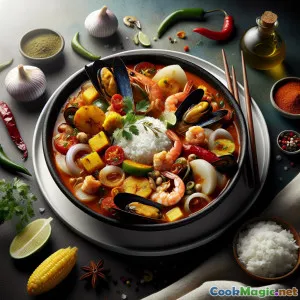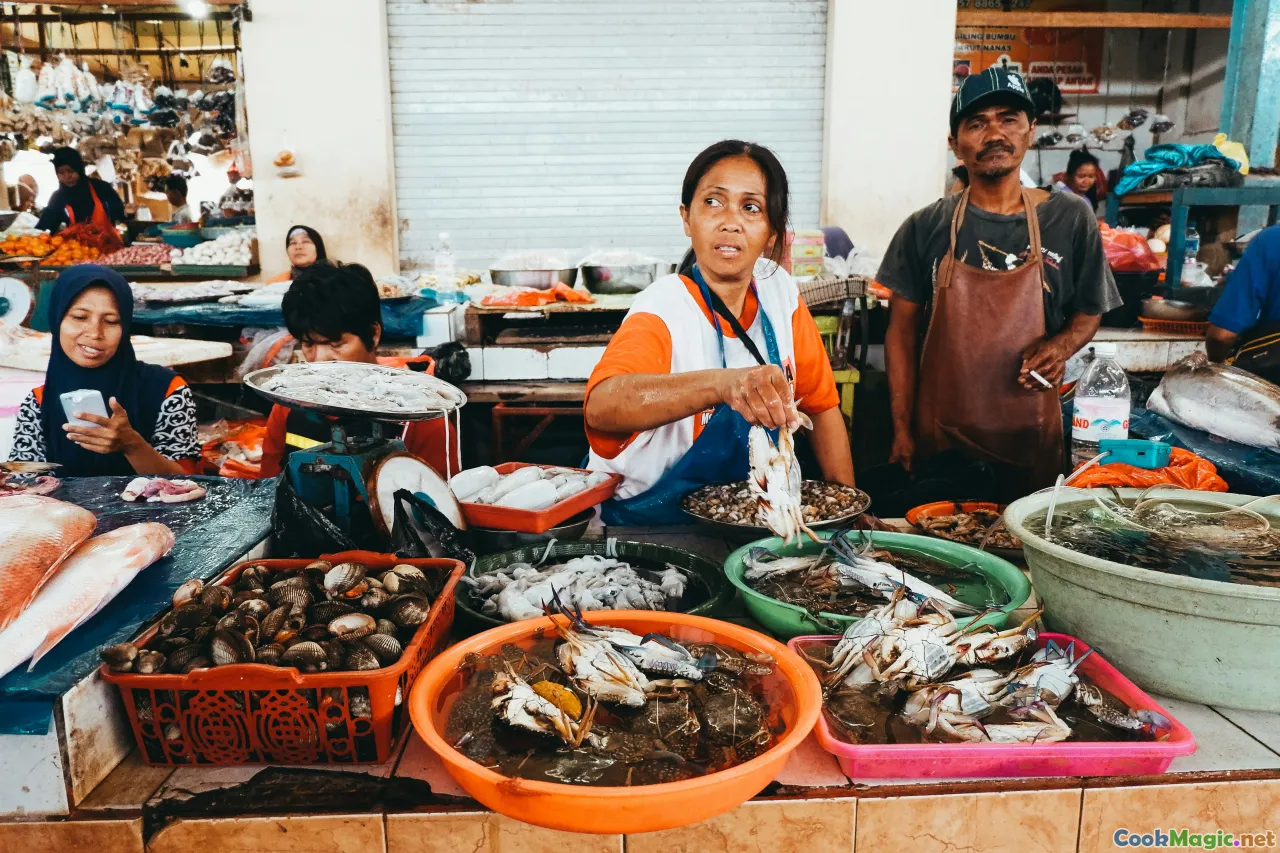
配木蕉的岛屿海鲜桑科乔
(Island Seafood Sancocho with Plantain)
(0 评论)食材
-
2 tbsp 安纳托油(安纳托籽浸油)
(Substitute with olive oil if unavailable)
-
0.5 cup Sofrito
(Puerto Rican-style; homemade or store-bought)
-
1 medium 黄洋葱,切丁
(White onion works too)
-
1 medium 红椒丁
(增加甜味和颜色)
-
4 cloves 大蒜(剁碎)
(Fresh garlic for best flavor)
-
2 medium 切碎的番茄
(Roma or vine-ripened)
-
2 leaves 香菜叶(recao),切碎
(Use extra cilantro if unavailable)
-
0.5 cup 香菜,切碎
(Divided for cooking and garnish)
-
2 medium 青蕉,去皮并切成块状
(Use green (unripe) for starchy body)
-
400 grams 木薯(cassava),去皮并切成块
(Remove woody core)
-
250 grams Yautía(芋头/马兰加),去皮并切成块
(增加丝滑感)
-
300 grams 加勒比海南瓜,切成方块
(Kabocha or butternut works)
-
2 ears 玉米穗,切成圆片
(Fresh or frozen cobs)
-
1500 ml 鱼或海鲜高汤
(低钠优先)
-
200 ml 椰奶
(Adds creaminess; optional but lovely)
-
1 packet 带有 achiote 的 Sazón
(Choose gluten-free if needed)
-
1 tsp 干牛至
(Preferably Caribbean oregano)
-
0.5 tsp 磨碎的孜然
(Gently earthy)
-
1 tsp 熏制红椒粉
(For a subtle smoky note)
-
2 leaves 月桂叶
(上菜前请移除)
-
2 tsp 细海盐
(根据口味调整)
-
0.5 tsp 黑胡椒
(新鲜磨碎)
-
2 tbsp 青柠汁
(新鲜压榨)
-
1 small 斯科奇辣椒或 ají dulce,去籽并剁碎
(Use ají dulce for flavor without heat)
-
300 grams 大虾,去壳去肠
(新鲜或解冻)
-
500 grams 贻贝,已清洗并去须
(Discard any that don’t close when tapped)
-
200 grams 鱿鱼圈
(Pat dry)
-
300 grams 坚实的白肉鱼(mahi-mahi 或鳕鱼),切成方块
(1–2 inch chunks)
-
2 tbsp 新鲜香菜,切碎(装饰)
(用于上菜)
-
4 cups 供上桌用的熟白米
(Optional accompaniment)
(Substitute with olive oil if unavailable)
(Puerto Rican-style; homemade or store-bought)
(White onion works too)
(增加甜味和颜色)
(Fresh garlic for best flavor)
(Roma or vine-ripened)
(Use extra cilantro if unavailable)
(Divided for cooking and garnish)
(Use green (unripe) for starchy body)
(Remove woody core)
(增加丝滑感)
(Kabocha or butternut works)
(Fresh or frozen cobs)
(低钠优先)
(Adds creaminess; optional but lovely)
(Choose gluten-free if needed)
(Preferably Caribbean oregano)
(Gently earthy)
(For a subtle smoky note)
(上菜前请移除)
(根据口味调整)
(新鲜磨碎)
(新鲜压榨)
(Use ají dulce for flavor without heat)
(新鲜或解冻)
(Discard any that don’t close when tapped)
(Pat dry)
(1–2 inch chunks)
(用于上菜)
(Optional accompaniment)
营养
- 份量: 6
- 每份大小: 1 bowl (400g)
- Calories: 520 kcal
- Carbohydrates: 48 g
- Protein: 35 g
- Fat: 18 g
- Fiber: 7 g
- Sugar: 6 g
- Sodium: 1200 mg
- Cholesterol: 220 mg
- Calcium: 160 mg
- Iron: 3.2 mg
制作步骤
-
1 - Prep the seafood:
Rinse and pat dry shrimp, mussels, calamari, and fish. Refrigerate until needed. Discard any broken mussels or those that remain open after a firm tap.
-
2 - Sauté Aromatics:
Warm achiote oil in a large heavy pot over medium heat. Add onion, bell pepper, garlic, and sofrito. Cook until fragrant and softened, 6–8 minutes, stirring.
-
3 - Build the Flavor Base:
Stir in tomatoes, sazón, oregano, cumin, smoked paprika (if using), minced ají dulce or a tiny bit of Scotch bonnet, bay leaves, salt, and pepper. Cook 2–3 minutes.
-
4 - Add stock and roots:
Pour in seafood stock. Bring to a gentle boil, then add plantain, yuca, yautía, and calabaza. Reduce heat to a steady simmer.
-
5 - Simmer to Tender:
Cover and simmer until the starchy roots are fork-tender but not falling apart, about 25–30 minutes. Stir occasionally to prevent sticking.
-
6 - Corn and coconut:
Add corn rounds and coconut milk (if using). Simmer another 8–10 minutes to meld flavors and lightly enrich the broth.
-
7 - Seafood in stages:
Add fish and calamari first; simmer 3 minutes. Add shrimp and mussels; cover and cook 4–5 minutes until shrimp are pink and mussels open. Discard any unopened mussels.
-
8 - Finish and balance:
Stir in lime juice and half the chopped cilantro. Taste and adjust salt, pepper, or acidity to preference.
-
9 - Rest and Serve:
Let the sancocho rest 5 minutes off heat to settle. Ladle into warm bowls, garnish with remaining cilantro, and serve with cooked white rice if desired.
-
10 - Store and reheat:
Cool leftovers quickly. Refrigerate up to 2 days. Reheat gently; add a splash of stock or water to loosen. Add fresh herbs and a squeeze of lime before serving.
Rinse and pat dry shrimp, mussels, calamari, and fish. Refrigerate until needed. Discard any broken mussels or those that remain open after a firm tap.
Warm achiote oil in a large heavy pot over medium heat. Add onion, bell pepper, garlic, and sofrito. Cook until fragrant and softened, 6–8 minutes, stirring.
Stir in tomatoes, sazón, oregano, cumin, smoked paprika (if using), minced ají dulce or a tiny bit of Scotch bonnet, bay leaves, salt, and pepper. Cook 2–3 minutes.
Pour in seafood stock. Bring to a gentle boil, then add plantain, yuca, yautía, and calabaza. Reduce heat to a steady simmer.
Cover and simmer until the starchy roots are fork-tender but not falling apart, about 25–30 minutes. Stir occasionally to prevent sticking.
Add corn rounds and coconut milk (if using). Simmer another 8–10 minutes to meld flavors and lightly enrich the broth.
Add fish and calamari first; simmer 3 minutes. Add shrimp and mussels; cover and cook 4–5 minutes until shrimp are pink and mussels open. Discard any unopened mussels.
Stir in lime juice and half the chopped cilantro. Taste and adjust salt, pepper, or acidity to preference.
Let the sancocho rest 5 minutes off heat to settle. Ladle into warm bowls, garnish with remaining cilantro, and serve with cooked white rice if desired.
Cool leftovers quickly. Refrigerate up to 2 days. Reheat gently; add a splash of stock or water to loosen. Add fresh herbs and a squeeze of lime before serving.
关于 配木蕉的岛屿海鲜桑科乔 :的更多信息
Sancocho de Mariscos Isleños: A Coastal Puerto Rican Embrace
Sancocho is comfort in a cauldron, a communal pot where land and sea meet. This island-style seafood sancocho draws its soul from Puerto Rico’s coastline—think briny breezes, green plantains, and the herb-laced heartbeat of sofrito. The result is a vibrant stew with tender root vegetables, sweet corn, and a chorus of shrimp, mussels, squid, and flaky fish. A swirl of coconut milk brings a subtle, tropical roundness, while lime and cilantro brighten everything at the finish.
What Makes This Version Special
- Layered, island-forward aromatics: Achiote oil provides an amber sheen and gentle nuttiness, while sofrito (onion, garlic, peppers, herbs) builds unmistakable Puerto Rican character.
- Starchy stamina: Green plantain, yuca, yautía, and calabaza contribute body, natural sweetness, and silky texture—no roux needed.
- Seafood in stages: Fish and squid first, then shrimp and mussels. This timing respects each seafood’s ideal doneness for a tender, luxurious spoonful every time.
- Coconut’s whisper: Optional coconut milk enriches without dominating. It softens edges and marries ocean brine to garden warmth.
Tips, Tricks, and Substitutions
- Stock matters: A good seafood stock (homemade from shells and fish frames) will elevate the stew. If using store-bought, choose low-sodium to control seasoning.
- No culantro? Use extra cilantro and a pinch more oregano. Culantro’s long leaves deliver a deeper, more savory “green” note, but the stew remains lovely without it.
- Heat management: Aji dulce adds fruity aroma with nearly no heat. If using Scotch bonnet, start small—this stew should be warm and lively, not fiery.
- Root readiness: Cut denser roots (yuca, plantain) slightly smaller than calabaza so they finish around the same time. Remove yuca’s fibrous core to avoid stringy bites.
- Coconut calibration: For a lighter stew, skip the coconut milk; for creamier, add a splash more. Either way, keep the seafood as the star.
- Gluten-free note: Many sazón blends are naturally gluten-free, but always check labels to be certain.
- Make-ahead: The base (through Step 6) can be prepared a day ahead. Reheat to a gentle simmer, then add the seafood just before serving.
Serving Suggestions
- Classic pairing: A scoop of hot white rice alongside (not in) the bowl lets you customize each mouthful.
- Bright finishers: Extra lime wedges, thin-sliced scallions, or a few cilantro stems make the bowl pop. A drizzle of good olive oil is also welcome.
- Textural contrasts: Crisp tostones or cassava crackers add crunch to balance the stew’s plushness.
Cultural Notes and History
Sancocho is found across the Caribbean and Latin America, evolving with each shoreline and valley. In Puerto Rico, you’ll meet versions starring chicken, pork, or beef—especially for gatherings and holidays—yet coastal cooks often turn to the ocean. “Isleño” here signals an island sensibility: a reliance on what’s landed that morning and what’s grown in the garden. The pot becomes a tapestry of migration and trade—cassava from ancient Taíno traditions, Spanish-introduced sofrito styles, and African and Canary Island influences woven through spices, techniques, and tastes.
Seafood sancocho is celebratory but practical, a way to stretch the day’s catch with roots and corn so everyone eats well. The practice of adding seafood in stages reflects respect for the ingredient: calamari toughens if overcooked, fish flakes apart, mussels need steam and time to open. Done right, the flavors feel layered yet clear—each spoon delivering sweet corn, creamy calabaza, sea-scented broth, and a tender bite of seafood.
Chef’s Notes and Personal Thoughts
- Balance is the key. Salt, acidity, and herbal freshness should be in harmony. If the stew tastes dull, add a pinch of salt. If it’s heavy, squeeze more lime. If it’s briny, a splash of coconut milk smooths the edges.
- Don’t rush the roots. That slow simmer—the time when the kitchen fills with sofrito and annatto perfume—is where your broth’s depth comes from.
- Garnish with intention. Cilantro at the end isn’t an afterthought; it’s the final brushstroke that wakes the bowl up.
This Sancocho de Mariscos Isleños honors tradition while offering flexibility for the modern kitchen. It’s the kind of dish that invites friends to linger, spoons to clink, and stories to unfold—an edible postcard from Puerto Rico’s shores.

















